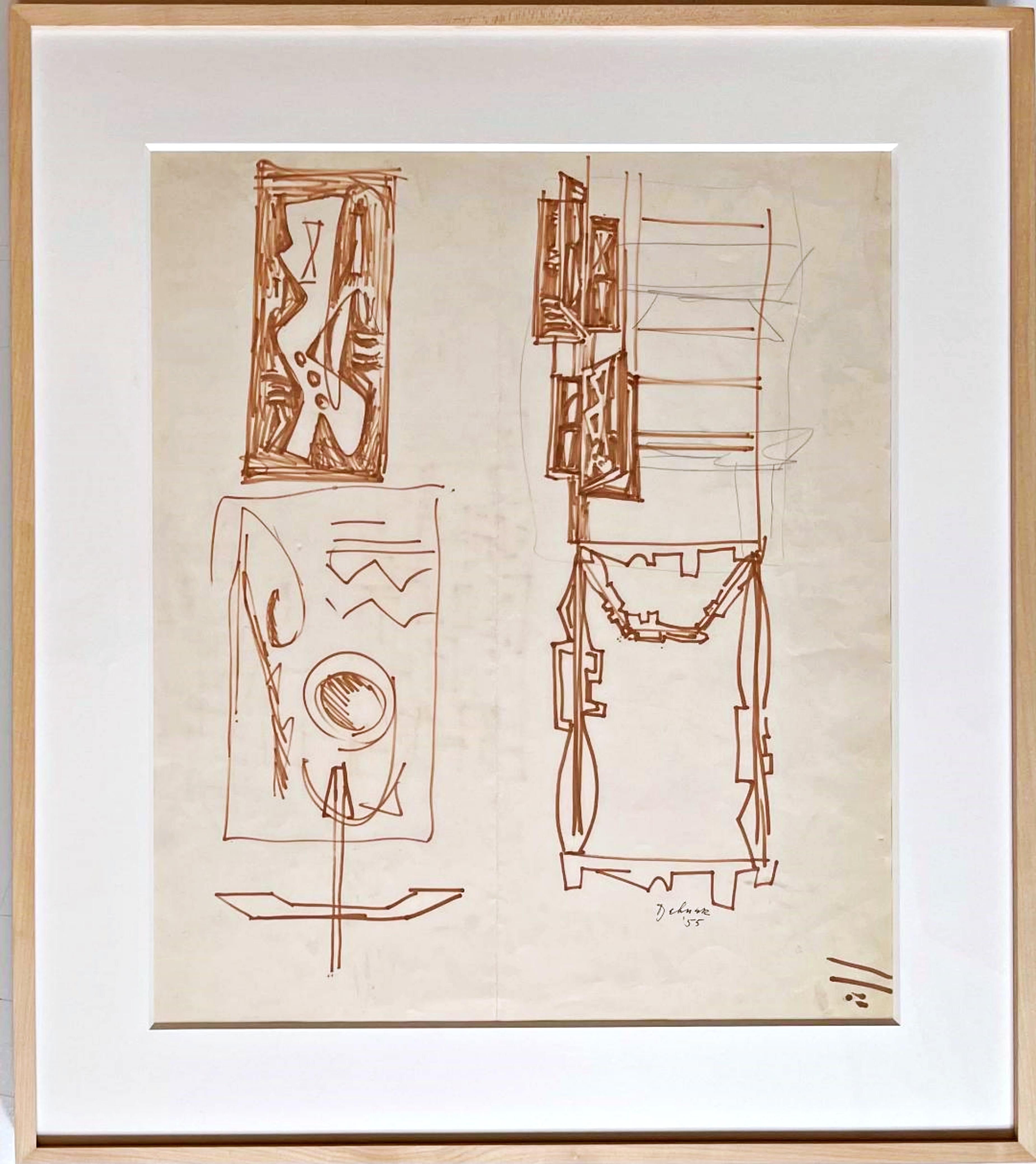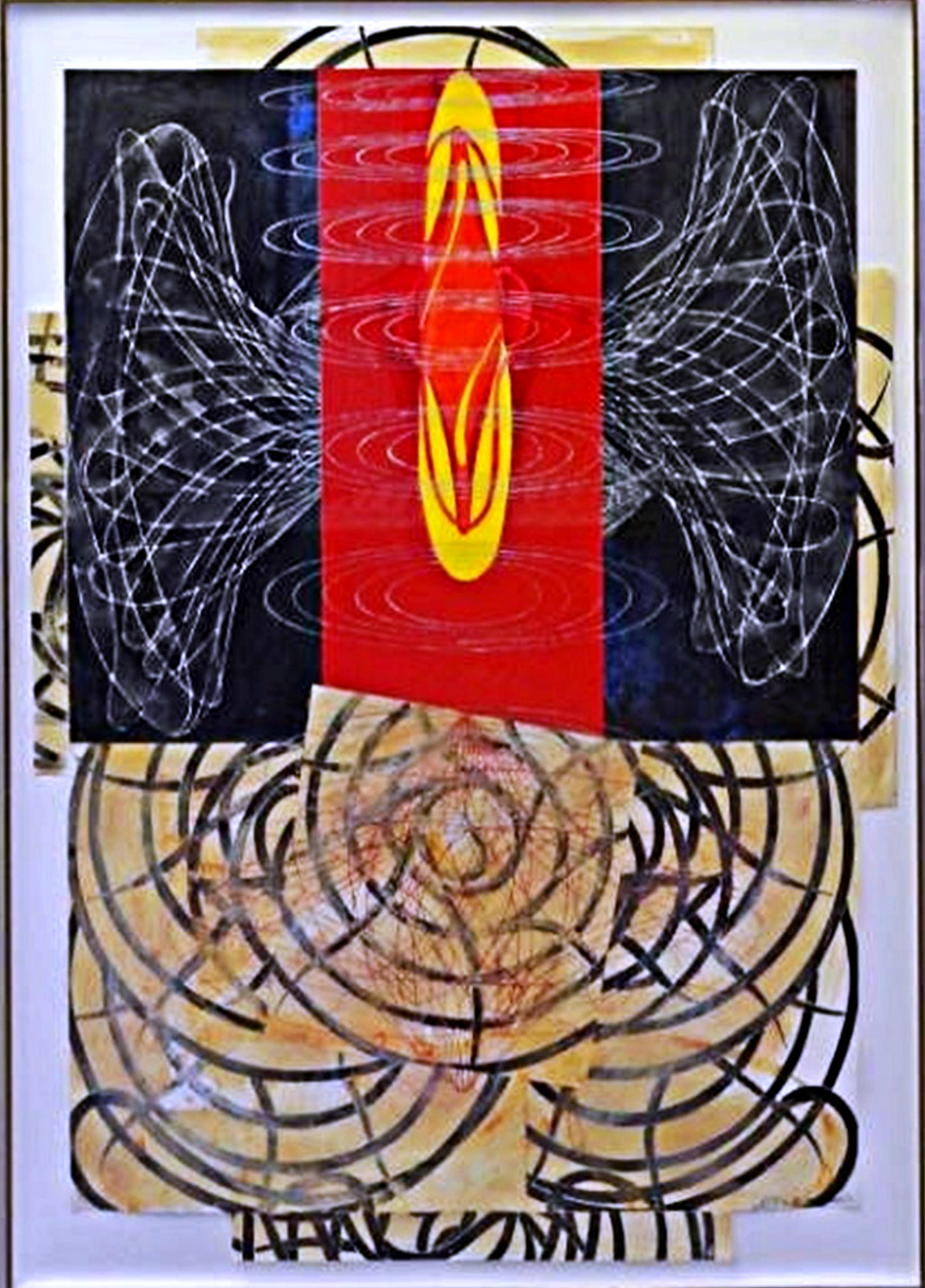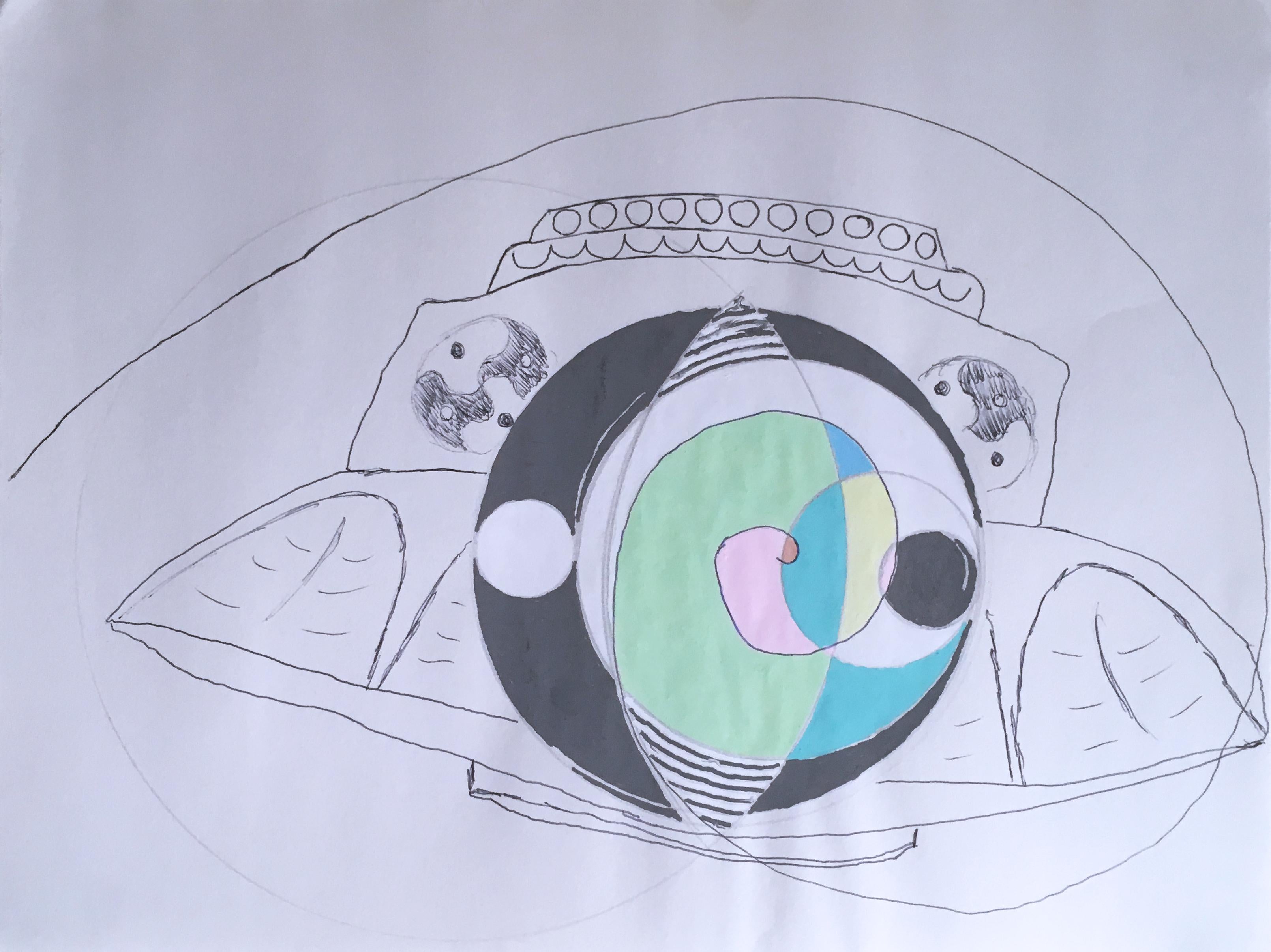Items Similar to Le jour se lève
Want more images or videos?
Request additional images or videos from the seller
1 of 6
Philippe HuartLe jour se lève2021
2021
About the Item
Signed, titled and dated on the verso.
Acquired directly from the artist.
Free shipment worldwide.
Working on a variety of perceptual levels, Philippe Huart lets one visit his intimate diary entries or take a tour of his fantasies. His canvases suggest several different readings – aesthetic, message-laden, lyrical, or realistic in a fictional take on the everyday – so as to account for both the uniformity and the disorder of the visual information that is bombarding us. Whether he is depicting a gun, bonbons, flowers, or pharmaceutical tablets, Huart’s concern is not to reveal, through his iconography, what grounds the established metaphorical relations between objects, and that just makes them more fascinating. The painter favors reflective surfaces on which the surrounding spectacle, out of frame, comes to fit like a film on the screen. Starting with Pop Art-related imagery, he creates a universe populated with gleaming capsules, tired flowers, and tangy candy treats. His sumptuous sweets are piled up, packed in, juxtaposed, enlarged, and fragmented. From the initial photographic document he removes those anecdotal features that might risk diverting one’s attention from the main subject matter of the composition. It is the treatment of the image, with all the attendant ambiguities of representation, that interests him. His work clings to the high-definition zones of images. But his canvases have little to do with their appearance or the objects being represented. They constitute, instead, a set of motivations and propositions. Thus, beneath their tempting colors, these capsules the painter prescribe do not conceal their pernicious side-effects, which, on account of their attractiveness, might otherwise be forgotten. Dependence on these new Gidean ”Fruits of the Earth” reveals the critical import of his work as well as its genuinely disturbing power. While the highly strict symmetry of his paintings – which divides the canvas in half lengthwise, thereby offering two realities that answer each other like a reflected image – affords one an idea of the sometimes extreme rigorousness of this approach, it no less remains the case that there is also room for humor, as the titles chosen for these pictures demonstrate. Through the reflections they give off (and as reinforced by the titles they are given, often in homage to 1970s Pop music), his works show display great complexity in his arrangement of graphic elements. It seems that the artist is less interested in a faithful reproduction of the image than in the optical illusion it represents. In this fake naturalism, the glossy perfection of what is being depicted borrows from the craftsmanship of this former advertising professional. His approach to the subjects of his paintings is conceptual, and he introduces words that put writing in a representational role as he combines text and images in a variety of ways that are always executed with a certain amount of finesse. He still loves the reflections of the outside world on the chrome-plated surfaces of revolvers, sugar-coated pills, or translucent candy wrappers… His taste for physical effects, his brush strokes, and his glazes are masterfully and knowingly expressed in a way that is reminiscent of the painters of Dutch still lifes. The miraculous meeting of panache and finish found in these harmonious volumes and colors gives his compositions a rhythmic perfection that is fascinatingly unique. The perfect finishing strokes on his works remove from them any purely philosophical, social, or protest message, though they also allow one to see through their insidious violence. Huart concentrates his efforts on a near-anaesthetizing, almost stupefying level of pictorial investigation where the meaning contained in the image spawns comparisons to conceptual artists. Paradoxically, his vibrantly polychromatic work reflects a quite somber, emotionally moving tonality that seems deeply marked by death. His painting is invigorated by intentions, or rather provocations, that do not represent, but instead create, another reality, one to which each viewer, depending on her experiences, emotions, and cultural background, can bring her own sensitive or cognitive response. Renaud Faroux, Paris
- Creator:Philippe Huart (1953, French)
- Creation Year:2021
- Dimensions:Height: 32.49 in (82.5 cm)Width: 42.52 in (108 cm)Depth: 1.97 in (5 cm)
- Medium:
- Movement & Style:
- Period:
- Condition:
- Gallery Location:Malmo, SE
- Reference Number:1stDibs: LU32813231102
About the Seller
5.0
Vetted Seller
These experienced sellers undergo a comprehensive evaluation by our team of in-house experts.
Established in 1967
1stDibs seller since 2013
224 sales on 1stDibs
Typical response time: 1 to 2 days
- ShippingRetrieving quote...Ships From: Malmo, Sweden
- Return PolicyA return for this item may be initiated within 14 days of delivery.
More From This SellerView All
- Au bout, la lumièreBy Philippe HuartLocated in Malmo, SEArtwork size: 100x70 cm Frame size 116x86 cm Signed, titled and dated on the verso. Acquired directly from the artist. Free shipment worldwide. Working on a variety of perceptual ...Category
2010s Abstract Abstract Drawings and Watercolors
MaterialsPaper, Pen, Graphite
- Trois bleus en diagonale.By James CoignardLocated in Malmo, SEAcquired directly from the artist. Unique artwork. Artwork size: 9,5 x 17 cm. Frame size: 27 x 34 cm Frame in silver. Museum glass anti-reflective. Free shipment worldwide. “With ju...Category
Early 2000s Abstract Mixed Media
MaterialsMixed Media
- Foot Musik.By Roberto MattaLocated in Malmo, SEPastel, gouache and coffee on paper. Artwork size: 58 x 56 cm. Frame size: 78 x 76 cm. Free shipment worldwide. Acquired directly from the artist. Archive number (P90/37) “The heart is an eye,” writes Nobel laureate Octavio Paz in an essay on Matta’s paintings. Matta creates a world coloured both by a sunny faith in the future and by visions of impending doom. Roberto Sebastian Echaurren Antonio Matta, who died aged 91 on 23 November 2002, was born in Santiago, Chile, on 11 November 1911 into a family with Spanish, French and Basque roots, and raised in an atmosphere of religiosity. By the age of 21 he had graduated and begun work as an architect, but his leisure time he devoted to sketching and painting. In 1933 he travelled to Europe for the first time, visiting Greece, Yugoslavia, Italy and other countries, and subsequently taking the initiative to collaborate with the architect, Le Corbusier. As time passed, however, Matta’s enthusiasm for a career in architecture waned, and he began to devote himself full-time to art, making early acquaintances with surrealists such as Max Ernst, Salvador Dalí, André Breton and others. Between 1939 and 1948 Matta, like many of his artistic contemporaries, lived in self-imposed exile in the USA, but, after almost 10 years’ absence from Europe, he returned to make first Rome and then, a few years later, Paris his home. Throughout most of the rest of his life Matta commuted between his studio in Paris and his creative refuge in the monastery outside Rome. And it is here, in Italy, that he produced his greatest paintings. Matta’s first retrospective in Sweden was organised in 1956 when his works were exhibited in what was then Galerie Colibri – run by, among others, the artist C O Hultén at number 36 Södra Förstadsgatan in Malmö, Sweden. This was also the time when Matta began to collaborate with poets and other artists in Sweden. He produced the illustrations for Lasse Söderberg’s first anthology of poems, Akrobaterna (“The Acrobats”), published in 1955, and was also responsible for the cover of the Swedish art and literary magazine Salamander. In 1959 the first museum exhibition of Matta’s work in Europe was arranged at the Museum of Modern Art (Moderna Museet) in Stockholm. Held under the aegis of Pontus Hultén, it was entitled “Fifteen Forms of Doubt” and included 15 or so gigantic paintings...Category
1990s Abstract Mixed Media
MaterialsMixed Media
- SF 89-153.By Sam FrancisLocated in Malmo, SEArtwork size: 67 x 51 cm. Frame size: 112 x 97 cm. Free shipment worldwide. Archive number SF 89-153 in the Sam Francis Foundation. Stamped with the Sam Francis Estate logo and stamped signature on verso. Sam Francis’s paintings are a journey into a dream, a voyage into the landscapes of the soul where colours are lights on fire. Alongside names such as Jackson Pollock, Willem de Kooning and Franz Kline, Sam Francis is an artist who has succeeded in demonstrating a total mastery of abstract expressionism’s impassioned and spontaneous genre. The explosions of colour – red, blue, green and yellow – the streaks, strokes and bold lines of his pictures are the physical synthesis of the deepest crevices of the soul. His colours create rhythmical motifs that, characteristically enough, can be called the “musicality” of his paintings. The work of Sam Francis provides a visible meeting place for the conscious and the unconscious. His pictures are the cross-fertilisation of what has already been experienced with what exists still only as desire, a struggle between melancholy and merrymaking. Influenced by C.G. Jung, the father of psychoanalysis, Sam Francis spent a large portion of his life exploring the premise that dreams, instincts and intuition provide, the keys which unlock the mysteries and meaning of our inner lives. He was also fascinated by the four ancient elements – earth, water, air and fire – which developed into a leitmotif in his work. Sam Francis was born in San Mateo in California, USA in 1923. After starting to paint at the age of around twenty, he soon found himself increasingly consumed by the power of art. He spent much of the 1950s in Paris, from where he not only made frequent excursions to a number of European cities, but also embarked on many journeys to South America and Asia. He continued to move from place to place, primarily in the USA and Japan, right up until his death in 1994. Sam Francis’s first...Category
1980s Contemporary Abstract Paintings
MaterialsPaper, Acrylic
- Foot MusikBy Roberto MattaLocated in Malmo, SEArtwork size: 56 x 58 cm. Frame size: 76 x 78 cm. Free shipment worldwide. Archive number (P90/36) Acquired directly from the artist. “The heart is an eye,” writes Nobel laureate Octavio Paz in an essay on Matta’s paintings. Matta creates a world coloured both by a sunny faith in the future and by visions of impending doom. Roberto Sebastian Echaurren Antonio Matta, who died aged 91 on 23 November 2002, was born in Santiago, Chile, on 11 November 1911 into a family with Spanish, French and Basque roots, and raised in an atmosphere of religiosity. By the age of 21 he had graduated and begun work as an architect, but his leisure time he devoted to sketching and painting. In 1933 he travelled to Europe for the first time, visiting Greece, Yugoslavia, Italy and other countries, and subsequently taking the initiative to collaborate with the architect, Le Corbusier. As time passed, however, Matta’s enthusiasm for a career in architecture waned, and he began to devote himself full-time to art, making early acquaintances with surrealists such as Max Ernst, Salvador Dalí, André Breton and others. Between 1939 and 1948 Matta, like many of his artistic contemporaries, lived in self-imposed exile in the USA, but, after almost 10 years’ absence from Europe, he returned to make first Rome and then, a few years later, Paris his home. Throughout most of the rest of his life Matta commuted between his studio in Paris and his creative refuge in the monastery outside Rome. And it is here, in Italy, that he produced his greatest paintings. Matta’s first retrospective in Sweden was organised in 1956 when his works were exhibited in what was then Galerie Colibri – run by, among others, the artist C O Hultén at number 36 Södra Förstadsgatan in Malmö, Sweden. This was also the time when Matta began to collaborate with poets and other artists in Sweden. He produced the illustrations for Lasse Söderberg’s first anthology of poems, Akrobaterna (“The Acrobats”), published in 1955, and was also responsible for the cover of the Swedish art and literary magazine Salamander. In 1959 the first museum exhibition of Matta’s work in Europe was arranged at the Museum of Modern Art (Moderna Museet) in Stockholm. Held under the aegis of Pontus Hultén, it was entitled “Fifteen Forms of Doubt” and included 15 or so gigantic paintings...Category
1990s Surrealist Abstract Drawings and Watercolors
MaterialsMixed Media
- Foot MusikBy Roberto MattaLocated in Malmo, SEFrame size 76x78 cm. Free shipment worldwide. Acquired directly from the artist. Archive number (P90/41) “The heart is an eye,” writes Nobel laureate Octavio Paz in an essay on Matta’s paintings. Matta creates a world coloured both by a sunny faith in the future and by visions of impending doom. Roberto Sebastian Echaurren Antonio Matta, who died aged 91 on 23 November 2002, was born in Santiago, Chile, on 11 November 1911 into a family with Spanish, French and Basque roots, and raised in an atmosphere of religiosity. By the age of 21 he had graduated and begun work as an architect, but his leisure time he devoted to sketching and painting. In 1933 he travelled to Europe for the first time, visiting Greece, Yugoslavia, Italy and other countries, and subsequently taking the initiative to collaborate with the architect, Le Corbusier. As time passed, however, Matta’s enthusiasm for a career in architecture waned, and he began to devote himself full-time to art, making early acquaintances with surrealists such as Max Ernst, Salvador Dalí, André Breton and others. Between 1939 and 1948 Matta, like many of his artistic contemporaries, lived in self-imposed exile in the USA, but, after almost 10 years’ absence from Europe, he returned to make first Rome and then, a few years later, Paris his home. Throughout most of the rest of his life Matta commuted between his studio in Paris and his creative refuge in the monastery outside Rome. And it is here, in Italy, that he produced his greatest paintings. Matta’s first retrospective in Sweden was organised in 1956 when his works were exhibited in what was then Galerie Colibri – run by, among others, the artist C O Hultén...Category
1990s Surrealist Drawings and Watercolor Paintings
MaterialsGouache, Mixed Media
You May Also Like
- First Floor BiogramBy Kory TwaddleLocated in Kansas City, MOTitle : First Floor Biogram Materials : Acrylic, gouache, oil pastel, marker, charcoal, graphite, and conté crayon on paper Date : 2018 Dimensions : 24 x 18 x .1 in. Description : ...Category
2010s Abstract Expressionist Drawings and Watercolor Paintings
MaterialsPaint, Conté, Paper, Oil Pastel, Acrylic, Permanent Marker, Tempera, Wat...
- Untitled Mid Century Modern abstract sculptural drawingBy Dorothy DehnerLocated in New York, NYDorothy Dehner Untitled Mid Century Modern abstract sculptural drawing, 1955 Marker and graphite on paper Signed and dated by Dorothy Dehner in black felt tip pen on the front Frame ...Category
1950s Abstract Expressionist Abstract Drawings and Watercolors
MaterialsPermanent Marker, Graphite, Mixed Media
- In Real Time, unique signed Abstract Expressionist painting compared to MatisseBy Steven SormanLocated in New York, NYSteven Sorman In Real Time, 2003 Acrylic, gouache, gel medium, oil and beeswax collage painting on paper 48 × 34 inches Signed and dated 2003; The frame also bears the original label...Category
Early 2000s Abstract Expressionist Abstract Paintings
MaterialsMixed Media, Oil, Acrylic, Gouache, Gel Pen, Graphite
- Profil OrangeLocated in CANNES, FRPaco Rabanne ( 1934 -2023 ) " Profil Orange " 41 X 31 cm 49 X 39 cm framed . colored pencil , Gouache, felt-tip pen and graphite on paper . signed and dated 1999.Category
1990s Abstract Geometric Abstract Drawings and Watercolors
MaterialsFelt Pen, Color Pencil, Graphite
- Ode to Bob Lazar, 2020, gel pen, green, drawing, pink, ufo, science fiction, eyeBy Macauley NormanLocated in Jersey City, NJOde to Bob Lazar, 2020, gel pen ,ink and graphite on paper, green, abstract, drawing, pink, pattern, blue, yellow, black, ufo, science fiction, alien, yin ya...Category
2010s Contemporary Abstract Drawings and Watercolors
MaterialsPaper, Pen, Ink, Graphite
- The sprinkling of defiled persons (drawing)By Hunter StablerLocated in Philadelphia, PAThis is an original drawing on paper by Hunter Stabler measuring 12”h x 12”w x 2.5”d framed. The piece is made from graphite, ink, transfer paper and Gelly Roll® pen on paper. Hunter Stabler was born in Jefferson City, Missouri and was raised in upstate South Carolina. He received a BFA in painting from The Maryland Institute, College of Art and an MFA in painting from the University of Pennsylvania. He is currently pursuing an MFA in Digital Art at Louisiana State University. His work has been widely exhibited across the United States and internationally including exhibitions at the Morbid Anatomy Museum in Brooklyn, NY, The Shelburne Art Museum in Shelburne, VT, the Hunterdon Art Museum in Clinton, NJ, and the Islip Art Museum in East Islip, NY. His hand-cut paper artwork has been published in the books High Touch: Tactile Design and Visual Explorations, Push Paper, Strangers in the Nest (a book of Poems by Anselm Berrigan, Letterpress printed with images accompanying each poem), and published in Laminate Magazine, First Look Magazine, and American Craft Magazine. He was named “Philadelphia’s Next Hot...Category
2010s Contemporary Figurative Drawings and Watercolors
MaterialsGraphite, Paper, Ink, Ballpoint Pen
Recently Viewed
View AllMore Ways To Browse
Pennsylvania Valley
Philadelphia View Print
Cambodian Art
Klimt Print
Parisian Couture
Horizontal Modern Art Print
Israeli Artist Chagall
1832 Painting
Framed Tropical Prints
15th Century Oil
Prints Paintings Of Rain
Dakota Print
Chinese Floral Illustration
European Entrance Light
Wire Belt
Air Plane Poster
Japanese Buddhism
Fluorescent Acrylic





